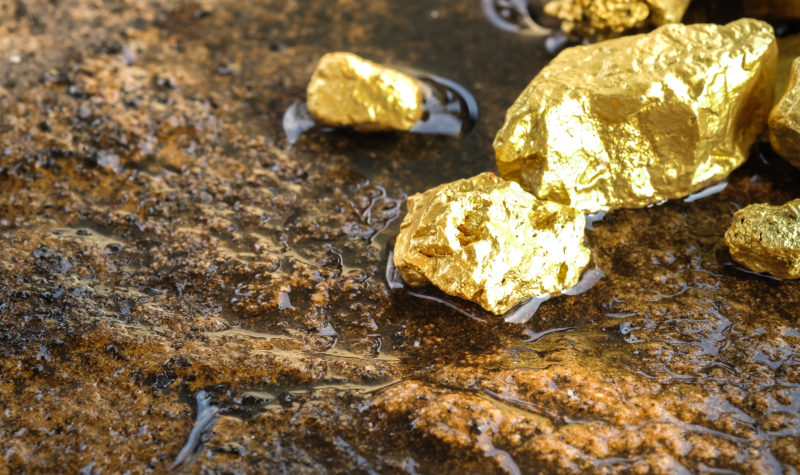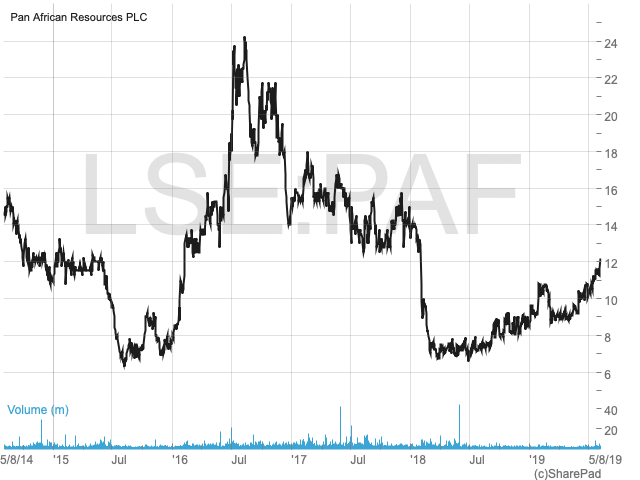Pan African Resources recovery has legs

With problems at its Evander mine behind it, shares in gold miner Pan African Resources are in recovery mode and could have further to go, writes John Cornford.
Let’s hope readers benefited from my gold article last month. Its rise has floated most listed gold boats higher, particularly in London where gold is now at an all-time high (in sterling terms) following the pound’s fall (£1,167 per troy ounce vs £1,150 in September 2011). Meanwhile, the dollar price for North American listed stocks is still 22% below its same $1,820 peak.
| Master Investor Magazine
Never miss an issue of Master Investor Magazine – sign-up now for free! |
And interesting that my one reservation (because it’s actually a silver miner and the silver price is dull), Ariana, has fallen by 20%. (Although perhaps investors have a dim view of Turkey.)
That rise in pound terms flags the question whether UK investors might have been pushing up UK based gold shares further than warranted if gold stutters or sterling recovers. Bear in mind that the ‘real’ world gold price is set, not in the US or London, but by demand and costs in mining countries, and by central banks in China and Russia who, it is said, have been leading this year’s rush into gold.
Anyway, that introduces my two gold shares this month, both recently strong but one of which I believe will outperform whatever gold or the dollar does, and the other of which I believe looks slightly vulnerable in any scenario.
My buy is Pan African Resources (LON:PAF), market cap: £270m @12.1p.
Unlike the junior miners I usually cover, aiming to spot the phase when their often sole mining project is about to reap rewards from starting production after years of spending, and when investors have seen their early support dented by constant fund raisings and diluted share prices, larger miners have portfolios of projects where the skill is to juggle spending across developing and producing mines to ensure a more even flow of total profits.
PAF comes somewhere in between, with its share history demonstrating how the differing performance of its relatively few projects has affected the total, but also the success of a strategy that saw its sub 3p debut price on AIM in 2004
peak at 21p in 2013, and then 23p in 2016, before problems arose (soon to be past history) in one of its acquisitions.
Pan African Resources – last five years

PAF started out to build value through exploration in Africa’s gold deposits, and then to use shares boosted by any success to acquire mines already in or near production, whose cash flow could be ploughed back into development and more acquisitions. That strategy delivered rising profits without any need for borrowings, and enabled PAF, unusually for an early stage miner, to pay dividends, a policy which remains a key objective and is a major reason for my interest now.
The first fruit of this strategy was the acquisition in 2007, cheaply for shares, of the prolifically cash generating Barberton Mines in the Eastern Transvaal, from conglomerate Metorex who was desperate to limit its exposure to the trouble then brewing in the world economy. After 130 years, Barberton still has a long life remaining which is being augmented by expansion into new mining areas, and has some of the world’s highest gold grades.
As is always a risk in mining however, PAF’s second key acquisition that had looked so promising in 2013, the Evander Gold Mines, bought cheaply from mining giant Harmony Gold (who said it needed the cash for a better project, although must have known it was selling PAF a bit of a pup) failed to become the ‘game changer’ that PAF had hoped for. That was because, while Evander still has much gold still in the ground, its old infrastructure turned out to need more spending than PAF felt justified in light of the then falling gold price, so that in 2018 the decision was made to close its underground workings.
That followed a few years of disappointing performance where from a peak of 73,416 ounces in 2016 (87% of Barberton’s), Evander’s underground production fell to 48,565 oz in 2018, and this year (to June 2019) will be only around 20,000 after its closure.
But against that, after further investment a more profitable tailings plant at the site has come into operation and will eventually almost completely replace previous production levels and add almost 50% to Barberton’s.
Those Evander problems caused overall profits to fall drastically in 2018 even before a large exceptional charge to close the mine, so that PAF’s overall earnings fell to a 5.15p loss per share, while the previous year’s 0.45p dividend was foregone.
Now, with the rapidly growing new tailings operation, and Barberton expanding and more efficient, Edison estimates that 2019 profits will have recovered enough to at least partly restore the dividend, with full restoration and possibly more in 2020 after a further sharp increase in available cash now that the closure and tailings construction is complete.
That estimate is based on a $1,305/oz gold price, so if the present $1,414/oz is maintained there will be a further boost, in which case Edison’s forecast of a 0.56p dividend would deliver a 4.8% yield at the present 11.5p share price. By then however, we would expect the shares to be considerably higher with the prospect of an even larger dividend.
Note from the chart the relatively low volume so far in this recovery phase. I think that is reassuring. Spikes in share prices are definitely not to be chased.
What about that other (I think vulnerable) gold miner? Find out which company I’m avoiding HERE.

Comments (0)